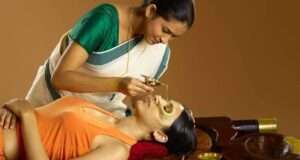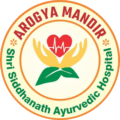Netra Aschotan

Ayurveda, the ancient Indian system of medicine, has been a beacon of holistic health for centuries. Among its many treasures is Netra Ashchotan, a therapeutic approach specifically designed for addressing various eye disorders. In this article, we will delve into the intricacies of this Ayurvedic therapy, exploring its origins, components and benefits.
Understanding Netra Ashchotan
Definition and Origin
Netra Ashchotan, derived from Sanskrit, translates to “eye rejuvenation.” Its roots can be traced back to ancient Ayurvedic texts, where it was considered a vital element in maintaining overall well-being. This therapy is meticulously crafted to bring balance to the doshas, particularly focusing on the eyes’ health.
Key Components and Their Benefits
In simple terms, when milk, oil, ghee, or a herbal solution flows into the eyes, it’s known as Netra Ashchotan. This liquid is released about 4 centimeters above, right between the eyes and the nose. It then spreads across the eyes and exits from the other side. This flow has a mildly warm temperature, neither too cold nor too hot. This gentle warmth helps in relaxing the eyes and easing strain. Ingredients like Triphala. ghee work synergistically to cleanse, nourish, and rejuvenate the eyes. Triphala, a blend of three fruits, acts as a powerful antioxidant, while herbal decoction provides essential minerals crucial for eye health. Ghee, especially cow ghee, contributes to the overall soothing and calming effects of the therapy.
Common Eye Disorders Addressed
Ayurveda recognizes the diversity of eye disorders and positions Netra Ashchotan as a versatile solution. Whether it’s cataracts, glaucoma, conjunctivitis, or myopia, this therapy aims to alleviate symptoms and, in some cases, reverse the condition. The holistic approach ensures that the root cause of the disorder is addressed, promoting long-term eye health.
The Process of Netra Ashchotan
Preparation of Herbal Ingredients
The preparation of Netra Ashchotan involves a meticulous process of selecting, grinding, and blending various herbs. The combination is customized based on the individual’s dosha imbalance and specific eye condition. This personalized touch enhances the therapy’s effectiveness. In some cases, plain milk is also beneficial.
Application Method
Typically administered as an eye wash, Netra Ashchotan requires precision in application. The therapeutic solution penetrates the eye tissues, working its magic on a cellular level. The process is painless and often induces a sense of relaxation.
Duration and Frequency
The duration of Netra Ashchotan varies based on the severity of the eye disorder. However, it is generally recommended to undergo the therapy for a 1 week period, followed by regular check-ups. The frequency of application is tailored to individual needs, ensuring a gradual and sustainable improvement.
Benefits of Netra Ashchotan
Improving Vision
One of the primary benefits of Netra Ashchotan is its ability to enhance vision. The therapy’s holistic approach not only addresses existing issues but also promotes overall eye health, leading to sharper and clearer vision.
Reducing Eye Strain
In our modern, screen-dominated lives, eye strain has become increasingly common. Netra Ashchotan, with its calming properties, provides relief from strain, fatigue, and dryness, making it an ideal choice for those experiencing digital eye strain.
Preventing Further Deterioration
Regular application of Netra Ashchotan has shown promising results in preventing the progression of certain eye disorders. The therapy’s focus on rejuvenation and nourishment creates an environment conducive to healing.
Ayurvedic Perspective
Balancing Doshas for Eye Health
Ayurveda revolves around the concept of doshas, namely Vata, Pitta, and Kapha. Netra Ashchotan aims to bring these doshas into harmony, addressing the root cause of eye disorders. A balanced dosha ensures not just symptom alleviation but a sustainable, long-term solution.
Incorporating Netra Ashchotan into a Holistic Approach
Ayurveda emphasizes a holistic lifestyle, and Netra Ashchotan is no exception. Alongside the therapy, individuals are encouraged to adopt dietary changes, practice eye-friendly yoga exercises, and embrace meditation for overall well-being.
FAQs
Ayurvedic treatments can recover some eye disorders but may not cure all serious eye conditions. Consultation with medical professionals is essential.
The timeline for results varies based on individual factors. Consistent adherence to treatment plans enhances the likelihood of positive outcomes.
Ayurvedic remedies can be safe for children, but consultation with a qualified practitioner is crucial to ensure appropriate dosage and safety.
Ayurvedic treatment can be suitable for contact lens wearers, but precautions should be taken. Consultation with both Ayurvedic and ophthalmological experts is advisable.
Uniqueness of our therapies
At Arogya Mandir – Shri Siddhanath Ayurvedic Hospital, Miraj, we delve deeply into the ayurvedic examination of each patient. Utilizing noninvasive Ayurvedic diagnostic tools such as Ashtavidha Parikshan and Nadi Parikshan, we precisely determine the pathogenesis of the disease and then prescribe therapies tailored to the specific condition. This approach leads to expedited results.
Our therapies boast the following distinctive features:
– Tranquil and hygienic therapy rooms staffed with trained therapists in a positive environment.
– Selection of appropriate massage oil based on the patient’s Prakruti and the condition of the disease.
– Complimentary Prakruti and Dhatu Sarata examinations before the commencement of therapies.
– Authenticated procedures for each therapy.
– Judicious use of herbal medicines and instruments during the therapy sessions.
– Specialized rooms equipped with all facilities for inpatient care.
Feel free to share this article at no cost.
Copyright message – Dr. Prashant Chivate has published this article on drchivateayurved.org for informational purposes about diseases. Any other use of this article is strictly prohibited. All rights reserved.
